Local and foreign tourists flock to Hamilton Canal :
An enchanting waterway
By Ranil Wijayapala
Sri Lanka as a country rich in natural water ways and also man-made
canal and tanks has a proven history of using them for commercial
purposes and also for transportation. There is historical evidence to
support the fact that King Vira Parakramabahu VIII, of the Kotte era
during the 15 th century, used the canal on the West coast leading to
Negombo harbour, a famous harbour during that era, to transport precious
spices, gems and other valuable commercial items to be transported in
vessels to eastern nations with which Sri Lanka had trade links in the
past. Those water ways were further improved and many more new canals
were constructed by the colonial rulers as the country went under the
colonial rule of Portugese, Dutch and British from 1505 to 1948.
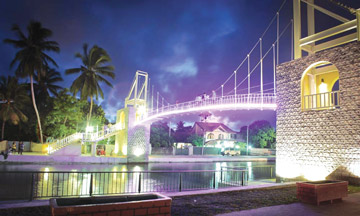 |
| Atop the
Hamilton bridge-a sight to behold |
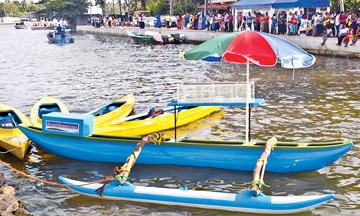 |
| Boat riding, a
popular pastime |
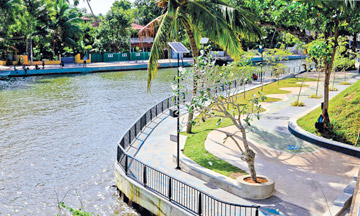 |
| The dredged
canal |
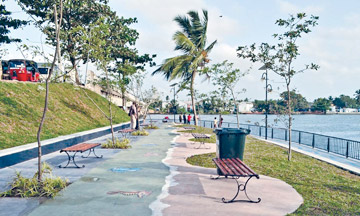 |
| Hamilton canal
walkway |
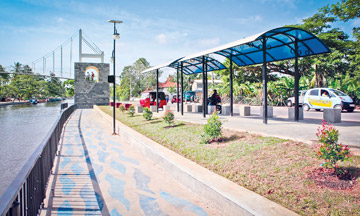 |
| Room to relax
and enjoy the surroundings |
The glory of those canal systems faced a natural death, during the
post independence era, as the canal system was not maintained. Now the
authorities have taken note of this fact and used after the improvement
of road network and other transportation modes unless the canal systems
were identified as a factor to improve environment, drainage system and
also a mode of transport and recreational purposes by the relevant
authorities recently.
As the potential behind these canal systems for the protection of
environmental, social development, transportation and also for the
promotion of tourism many canals and waterways are now being improved in
a rapid pace and they are becoming places of public attractions across
the country for recreational purposes.
Hamilton canal which was originally constructed by the Dutch and
later improved and strengthened by the British to link Colombo harbour
with the Negombo lagoon, after a long period of neglect is now being
systematically turned into a major tourist attraction in the country as
it has been transformed into eco-friendly and people-friendly as it has
been developed under the initiative of Economic Development Ministry as
a part of the programme to improve tourism in the Negombo area.
The Hamilton canal from the estuary of the Kelnai river at Hekitta in
the North of Colombo to Negombo lagoon has been completed in early
British era in 1802 and was in neglected state in the recent past as it
has become more of a dumping ground of garbage and a cess pit of many of
the households and factories along the canal.
The Economic Development Ministry understanding the importance of
developing this canal as a major tourism promotion zone handed over the
project to the Sri Lanka Land Reclamation and Development Corporation.
According to the Economic Development Ministry under the first stage
of the project a distance of eight kilometres from the Negombo Lagoon to
Dandugum Oya river delta was developed with the bank protection of the
canal. Work on the second stage, a 14 km-distance from Negombo Lagoon to
the mouth of the Kelani River at Hekiththa - commenced on February 20.
A major development work were done on two and half kilo meters from
Hekiththa junction to Pinwatta was developed as a major tourist
attraction and has been vested with the people in August this year
making the canal a major attraction for both foreign and local
tourists..
"The current project is aimed at not only tourism promotion but also
protecting the canal banks, fauna and flora, marine life and
biodiversity in the area. Improving the livelihood of residents and
providing them with the infrastructure they need are part of the
project", a spokesman for Economic Development Ministry said.
"The canal and its vicinity is of much environmental importance since
the area is home to different species of fish, birds and plants and rich
in bio-diversity, making it ideal for eco-tourism. In view of this,
embankments will be built to protect the canal banks and either side of
the waterway will be beautified.
In addition, the canal will be de-silted and steps will be taken to
prevent future pollution so that tourists will have the opportunity of
travelling by boat from Negombo to places like Muthurajawela, Kelani
Vihara and Dandugam Oya along Hamilton Canal with no difficulty.", the
spokesman added.
"After meeting the requirements of tourists visiting the area,
facilities for fishermen such as marketing stalls and jetties for boats
will be constructed", he said. Provincial Road Development Authority of
the Western Province which undertook the subcontract of the project from
SLLRDC in February 2013 to develop the stretch from Hekitta junction to
Pinwatta at a cost of Rs.400 million with the Japanese Bank for
International Cooperation assistance.
R.M.N. Thennakoonwela, Chief Engineer, Provincial Road Development
Authority which undertook the project from Hekiththa junction to
Pinwatta explaining the difficulties they faced when improving the canal
said that it was not like carpeting roads.
"The workers had to work in the canal which was like a cesspit. It
was a difficult job. We developed two- and- a- half kilometres of the
canal under such difficulty", he said.
"The major challenge we had to face initially was that the canal was
used as a dump site by the people. Even the drainage lines and storm
water connections and cesspits of houses and also some factories have
been connected to this canal. Therefore to improve the water quality, we
had to work within the existing legal framework and informed all the
household and the factories to take steps to divert all the pipe lines
connected to the canal to an alternative place within 14 weeks.
Then only we could stop the waste water connections, toilet
connections to the canal", Thennekoonwela said.
A committee comprising representatives from the Central Environment
Authority, Divisional Secretariat, Wattala Pradeshiya Sabha worked
together to make this project a success. Then the Wattala Pradeshiya
Sabha took steps to stop dumping garbage into the canal by introducing a
solid waste management system in the area.
"Then we protected the canal bank with gabian walls but it was not a
permanent solution as when boat operate in the canal the banks erode and
the gabian walls collapse.
Therefore we constructed reinforced concrete as capping for the
gabian wall so that the waves of the canal strike only the concrete
cap", engineer Thennekoonwela said. "But on the other side of the canal
towards the sea we had a small road along the canal. Therefore, we did
the gabian walling and then concreted the the road to make it strong",
he said.
"At Hekiththa junction people crossed the canal in a small ferry. As
a solution a suspension bridge across the canal was constructed to
facilitate crossing of the canal and five other bridges have been
repaired and reconstructed along the canal", he said.
The boatman who earlier transported people across the canal have been
given a jobs as watchers to take care of the bridge.
"Then to make this an attractive place for the tourists we did a
jogging path along the canal. Then we planted trees and constructed
benches for the people to relax. We installed solar power systems to
light the the streets", Thennekoonwela said.
"We also did a leisure park at Hekiththa junction for th people have
spend their leisure time while improving the environment along the canal
by planting trees and improving the fish stalls and bus stops. At
Elakanda junction we improve the fish market by having new stalls for
the people selling fish", he added.
About 30 contractors had to work like bees day and night since
February 20 to open the first stretch of the project on August 2, he
said.
Provincial Transport and Road Development Minister, Nimal Lansa on
the instructions of Economic Development Minister took the initiative to
develop this stretch of canal to promote tourism in Negombo.
"There should be a return for the investment for this project and the
Ministry of Economic Development and the Provincial Tourism Ministry aim
at promoting tourism in Negombo by making use of the canal for tourists.
The project is contributing towards improving tourism as it is a
major attraction for local and foreign tourists", Thennekoonwela said.
Apart from using the canal for boat rides it will promote marketing
of goods by using boats. A few boats have been launched to sell
essential items. |

